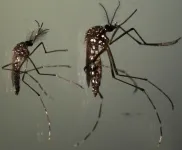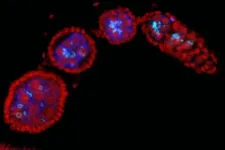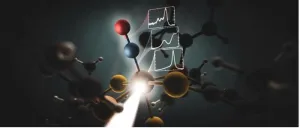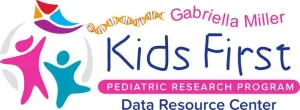(Press-News.org) Eggs of the mosquito that carries Zika virus can tolerate extended desiccation by altering their metabolism, according to a new study publishing October 24th in the open access journal PLOS Biology by Anjana Prasad, Sunil Laxman, and colleagues at the Institute for Stem Cell Science and Regenerative Medicine in Bengaluru, India and the Indian Institute of Technology in Mandi, India. The finding offers potential new ways to control the spread of this mosquito.
Cells are made mostly of water, and desiccation is a potentially fatal event for any organism, since the structures of many proteins and other cellular molecules are dependent on adequate hydration. While many types of microbes have evolved mechanisms to survive drying out, only a few animals have. Among them is the mosquito Aedes aegypti, the carrier of a variety of viral diseases, including, Zika, dengue, yellow fever, and Chikungunya. Originally found in North Africa, Ae. aegypti has expanded globally, and is now a threat in warm, moist regions throughout the world.
Aedes eggs require from 48 to 72 hours to hatch into larvae, and the authors first showed that eggs must be at least 15 hours old to survive desiccation; eggs that were dried out before this stage failed to hatch when rehydrated. They then compared the proteomes of viable eggs that had and had not been desiccated, and found multiple major changes in metabolic pathways within the desiccated eggs. These included increases in the levels of those enzymes in the tricarboxylic acid (Krebs) cycle that promote lipid metabolism, and a decrease in enzymes of glycolysis and ATP-producing parts of the TCA cycle, which together shunted cellular metabolism toward the production and use of fatty acids. Overall, the level of metabolism was reduced, while the levels of the amino acids arginine and glutamine were increased. In addition, enzymes that reduce the damaging effects of oxidative stress, a known consequence of dehydration, were also increased.
When linked together, arginine molecules form polyamines, which are known to help protect nucleic acids, proteins, and membranes from a variety of insults. Here, the authors showed that the eggs accumulate polyamines, suggesting that they may be a key aspect of desiccation tolerance. To test this, they fed egg-laying female mosquitoes an inhibitor of polyamine synthesis. The eggs that they laid were significantly less able to survive desiccation than eggs from untreated females. A second inhibitor, this one of fatty acid metabolism, also reduced egg viability after desiccation. Finally, they showed that this fatty acid inhibitor reduced polyamine synthesis, indicating that one role of the increase in fatty acid breakdown is to supply the energy needed for production of protective polyamines.
“Given the importance of Ae. aegypti as a primary vector for numerous viral diseases that affect nearly half the world’s population,” Laxman said, “as well as the rapid geographical expansion of this mosquito vector, these results provide a foundation for reducing Aedes egg survival and global spread. Additionally, some of the specific inhibitors described here that reduce desiccation resistance in Ae. aegypti eggs, as well as new ones affecting other steps in the egg desiccation tolerance pathway, may prove useful as vector-control agents.”
Laxman adds, “Aedes mosquito eggs can indefinitely survive after drying up completely, and hatch into viable larvae. The embryos rewire their metabolism upon drying, to protect themselves through desiccation, and revive after water becomes available again.”
#####
In your coverage, please use this URL to provide access to the freely available paper in PLOS Biology: http://journals.plos.org/plosbiology/article?id=10.1371/journal.pbio.3002342
Citation: Prasad A, Sreedharan S, Bakthavachalu B, Laxman S (2023) Eggs of the mosquito Aedes aegypti survive desiccation by rewiring their polyamine and lipid metabolism. PLoS Biol 21(10): e3002342. https://doi.org/10.1371/journal.pbio.3002342
Author Countries: India
Funding: No specific funding was obtained for this study. DST-INSPIRE (IF190149 to SS) and DBT/Wellcome Trust India Alliance (IA/I/19/1/504286 to BB) supported individual fellowships. These funders had no role in study design, data collection and analysis, support for experiments, decision to publish, or preparation of the manuscript. Intramural support was provided by the Tata Institute for Genetics and Society (to BB), and DBT-inStem (to SL).
END
A new study reveals biological mechanisms by which a specific strain of bacteria in the Wolbachia genus might enhance the fertility of the insects it infects—with potentially important implications for mosquito-control strategies. Shelbi Russell of the University of California Santa Cruz, US, and colleagues report these findings in the open access journal PLOS Biology on October 24th.
Different strains of Wolbachia bacteria naturally infect a number of different animals worldwide, such as mosquitos, butterflies, and fruit flies. Wolbachia can manipulate the fertility of their ...
The research team, led by Durham University, UK, used satellite data and radio-echo sounding techniques to map a 32,000 km2 area of land underneath the vast ice sheet.
They discovered a landscape that appears to have been formed by rivers at least 14 million years ago and possibly even before the initial growth of the East Antarctic ice around 34 million years ago.
This newly discovered landscape consists of ancient valleys and ridges, not dissimilar in size-and-scale to the glacially-modified landscape of North Wales, ...
Cleveland Clinic has been selected by Wellcome Leap to lead a quantum computing research project, while also playing a significant role in another led by Algorithmiq — both in collaboration with IBM Quantum.
The two contracts were won through Wellcome Leap’s Quantum for Bio Challenge, which will award up to $40 million to 12 researchers globally for research focused on accelerating the development of quantum computing applications for healthcare. Wellcome Leap is a U.S.- based non-profit organization founded by the Wellcome Trust to accelerate and increase ...
Scientists from the Department of Energy’s SLAC National Accelerator Laboratory have gained valuable insights into producing nitroxide, a molecule with potential applications in the biomedical field. While nitric oxide (NO) has long been on researchers' radar for its significant physiological effects, its lesser-known cousin, nitroxide (HNO), has remained largely unexplored.
The study, published recently in the Journal of the American Chemical Society, was born out of a joint endeavor between teams at SLAC’s Linac Coherent Light Source (LCLS) X-ray laser and Stanford ...
SAN FRANCISCO – A novel study conducted by a Japanese multicenter registry has revealed the significant benefits of using intravascular ultrasound (IVUS) in coronary intervention procedures. The comprehensive analysis, which focused on enhancing patient outcomes, has provided valuable insights into the effectiveness of IVUS in improving the success rates of these interventions.
The study, titled "Enhancing coronary intervention outcomes with the use of intravascular ultrasound: A comprehensive analysis of long-term benefits in Japanese multicenter registry," sheds light on the positive ...
Philadelphia, PA., October 24, 2023
WHO: The Gabriella Miller Kids First Pediatric Research Program (Kids First), an initiative of the National Institutes of Health (NIH)
WHAT: Kids First announces the release of nine robust new pediatric research datasets spanning childhood cancers, congenital disorders, and cross-condition data. New publicly available datasets include:
PEDIATRIC CROSS-CONDITION
Kids First and INCLUDE: Down Syndrome, Heart Defects, and Acute Lymphoblastic Leukemia
Principal ...
In a new case report, researchers at UCLA Health describe promising results using repetitive transcranial magnetic stimulation (rTMS) in the management of post-stroke cerebellar ataxia, a debilitating condition marked by impaired coordination and balance.
Cerebellar ataxia describes a group of neurological disorders that affect coordination, balance, and control of muscle movements. It results from damage or dysfunction of the cerebellum, a part of the brain responsible for coordinating voluntary movements. Ataxia can manifest as unsteady walking, difficulties with fine motor skills, and problems with speech, ...
Lingjia Liu, professor of electrical and computer engineering who is also an inaugural faculty member at the Virginia Tech Innovation Campus, has been awarded the Mobile Distributed Multiple-Input, Multiple-Output (Mobile dMIMO) project by the U.S. Department of Defense’s (DoD’s) Office of the Under Secretary of Defense for Research and Engineering (OUSD(R&E)) as part of its flagship FutureG program. The Mobile dMIMO project consists of three phases, with $9 million total planned funding — $1.5 million is for Phase 1 of the project. The Mobile dMIMO project represents one ...
Engineers at the University of California San Diego have developed a smartphone attachment that could enable people to screen for a variety of neurological conditions, such as Alzheimer’s disease and traumatic brain injury, at low cost—and do so accurately regardless of their skin tone.
The technology, published in Scientific Reports, has the potential to improve the equity and accessibility of neurological screening procedures while making them widely available on all smartphone models.
The attachment fits over a smartphone’s camera and improves its ...
Gene therapy currently represents the most promising approach for the treatment of hereditary diseases. Yet despite significant breakthroughs in recent years, there are still a number of hurdles that hinder the wider application of gene therapies. These include the efficient delivery of genetic material into target cells with minimal side effects using adeno-associated viral vectors (AAVs). The AAV carrier substances have an advantageous safety profile and high gene transfer efficiency, meaning they are often used in gene therapies and in gene editing with CRISPR/Cas. But, AAVs have limited DNA uptake capacity ...





